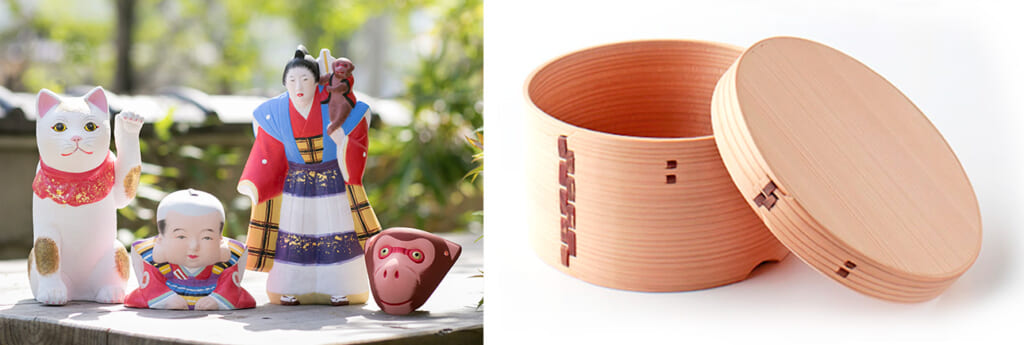The Nippon Club WEB Gallery Special Exhibition
Hakata Traditional Crafts Exhibition Magemon, Hariko and Imajuku Dolls -The beauty and skills inherited by female craftsmen- Virtual Opening Reception

Exhibition period: October 13 (Fri) – November 22 (Wed), 2023
Venue:The Nippon Club WEB Gallery
It is said that Japan's traditional crafts have entered a critical situation in recent years due to the lack of successors. Still, many artisans have carefully spun venerable conventional arts that have continued for generations to the present.
This exhibition spotlights Hakata Magemono, Hakata Hariko, and Imajuku dolls from among the traditional crafts that have been nurtured and passed down through a long history and tradition
in Hakata and introduce the beauty and skills of manufacturing handed down by female craftsmen.
One theory is that the origin of Hakata Magemono dates back to the time of Empress Jingong, and according to Kaibara Ekiken's book "Chikuzennokuni zokufudoki" in the Genroku period (1688〜1704), it was used as a ritual tool for Hakozaki Hachimangu Shrine at that time. Cedar and cypress boards are bent by applying heat, bound with cherry blossom bark, and made for daily necessities such as cooked rice containers, lunch boxes, and tea ceremony utensils. What makes it different from other regions is that it is not painted with lacquer or other materials but makes the most of the grain of the wood itself. It is also unique to Hakata to draw pictures directly on Magemono. In particular, the "Poppo-zen" set used at the beginning of eating to celebrate Shichi-go-san, which is an annual Japanese festival to celebrate the growth of children, and Okuizome, which is a ceremony that is held when a baby first begins to eat solid food is unique to Hakata that is not found in other regions. It depicts the "pine, bamboo and plum" and "crane and turtle " indispensable for celebrations. In this exhibition, we will introduce Magemono created by Yoshiko Shibata and the craftsmen of the “Shibata Toku Shoten,” the only Magemono Manufacturer remaining in Fukuoka City.
Hakata hariko has a history of being made as a lucky charm since the Edo period(1600-1868), and many promising works, such as tigers and dharmas, are still made. The method is almost the same as in the Edo period, and it is caused by gluing high-quality handmade Japanese paper and newspaper with flour glue in a mold made of earth and wood. After preparing the surface and drying it in the sun every time it is attached, it is a time-consuming folk craft that takes out the mold and colors it by hand one by one. Before the war, more than a dozen shops in Hakata made papier-mâché, but now only two have continued the tradition. At the exhibition, we will introduce works by Mr. Takashi Miura (5th generation hariko master) and his son's daughter-in-law, Tomoko, who is his successor. The hariko tiger was adopted for the Japan postal commemorative stamp in 1998 and became known to the Japanese nation.
The Imajuku doll that became the mother body of Hakata dolls began in 1905 when Mr. Seisuke Ohashi opened the Sekku doll "Ninsei" in Imajuku. Many things are connected to people's lives, such as traditional lifestyle, culture, and beliefs, and representative examples include "Monkey Mask" and "Sasano Saizo" to prevent fire and theft, and "Otafuku Mask" Imajuku dolls, which are simple but warm, have been loved by many people. The clay molds carefully used by Seisuke and the second-generation Shigeo are inherited, and Shigeo's niece, Yumiko Sato, continues to preserve the tradition. In this exhibition, we will also introduce creative clay dolls by Yumiko, who creates Imajuku dolls with the support of her family and her husband, Yoshiaki Sato, a traditional Hakata doll craftsman who judges Nitten and other events. Yumiko says that while preserving the new among the old, she wants to maintain the clay made from the local Nanakuma (Jonan Ward, Fukuoka City) because she believes that clay is the most crucial thing in doll making.
Please enjoy the beauty and skills of manufacturing handed down by female craftsmen.
Magemon, Hariko and Imajuku Dolls
-The beauty and skills inherited by female craftsmen-

From left to right: Tomoko Miura, Yumiko Sato, Yoshiko Shibata, Noriko Kitajima
Yumiko Sato of Imajuku Dolls, Tomoko Miura of Hakata Hariko, and Noriko Kitajima of Hakata Magemono will appear live and talk to us. For entertainment, you can enjoy jazz performances by a quartet of musicians from Fukuoka who are active in New York: Erika Matsuo (vocals), Yoshinori Waki (bass), Masami Ishikawa (guitar), and Takashi Inoue (drums).
The exhibition is organized by The Nippon Club and supported and made possible by the J.C.C. Fund (Philanthropic Fund of Japanese Chamber of Commerce and Industry in New York), in cooperation with Sekisho Corporation and Hakata Dentoushokuno Kai, and curated by Mie Tsunobe.
【Date】
Friday, October 13, 2023
7 – 8 pm(EST)
※Up to 500 people on a first-come, first-served basis
Register Here for the Virtual Reception
CONTACT: gallery@nipponclub.org








